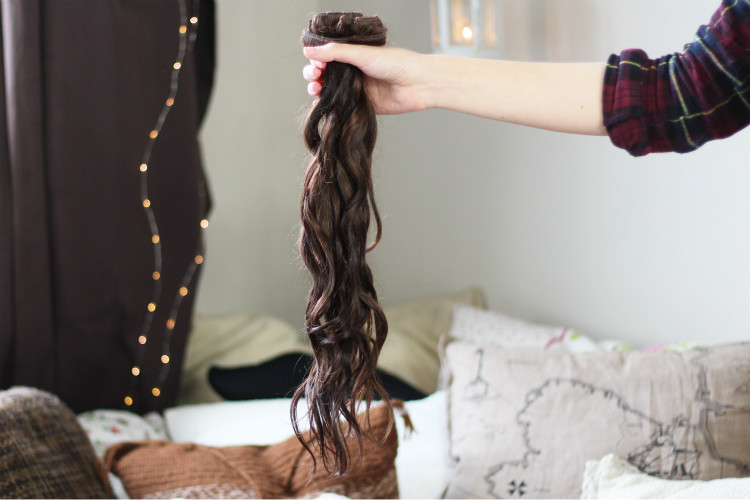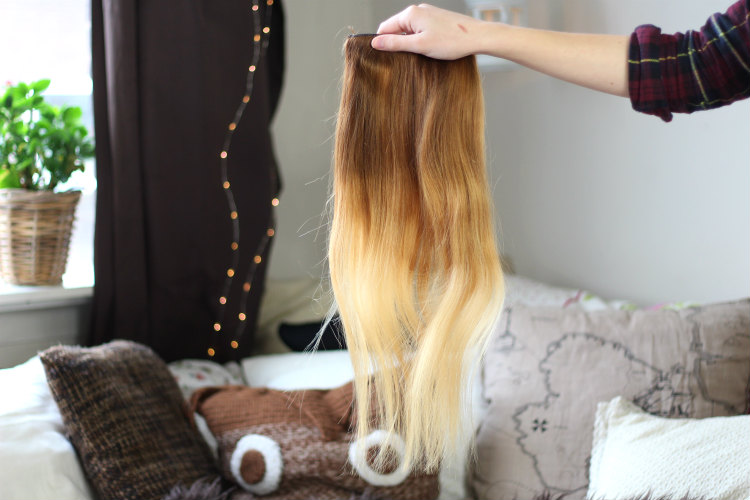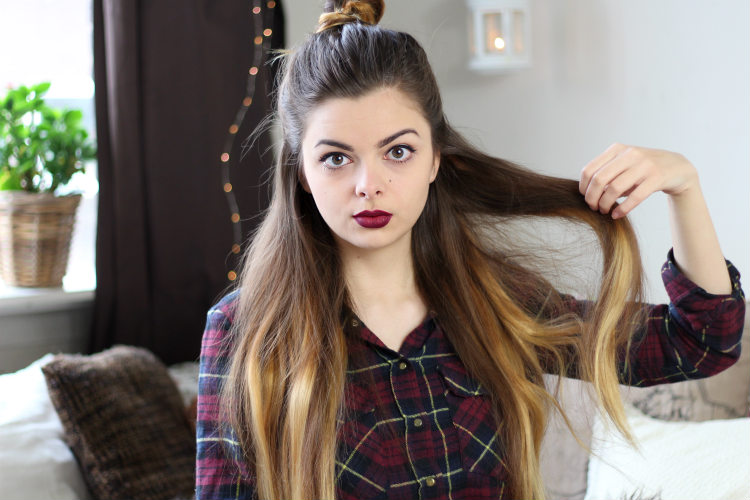Recently someone asked me if I could do a blog post about what to look out for when you’re buying hair extensions. Even though I’m not an expert in this field at all, I own a few sets of extensions, have seen a bunch of them in my life, and done a load of research, and now I present to you: Loepsie’s Hair Extension Buyers Guide. Let’s go!

Types of Extensions
There are different types of hair extensions, or actually different ways of attaching the extension hair to your own. They each have their pros and cons.
Glue-in
With this method, a strand of hair is attached to a little strand of your own hair by glueing them together using special glue or keratin and a heat tool. These extensions can stay in your hair for a couple of weeks, before the glue grows out too much and you need to get them re-attached.
You have to be very careful when washing your hair, heat-styling and using products while wearing glue-in extensions. Over-handling the bonds or using styling products on them can cause the glue to get damaged more quickly, and using heat tools on the glue will straight up dissolve it.
Glue-in extensions do look beautiful and very natural when applied well and are quite comfortable to wear.
Micro-Bead
With this technique the extension (again a small strand) is attached to your hair using a little bead or ring. This is considered a less damaging method than the glue, and you don’t have to worry about using styling products and heat with this one. You’ll still have to be careful while washing and brushing the hair though, as you don’t want to rip the extensions out.
These also look beautiful and very natural, but many people experience terrible knotting and matting around the extensions as it’s so hard to brush there.

Tape-in
This is kind of similar to the glue-in method, but instead of little strands, a strip of hair is used. It’s attached to a strip of glue, your own hair gets stuck down between two strips of glue. The advantage of this type of extension is that it lays flat on your head and looks natural, but I’ve heard bad stories about the glue dissolving and hair falling out. The glue is also said to be quite damaging to your own hair.
Sew-in
With the weave or sew-in method, a thin corn row braid is made across your head with your own hair, which a strip of hair extensions is then attached to by sewing it on. This allows you to get loads of extra hair in, and if the braids are done well, this is relatively damage-free. Downsides are the braiding can be a little painful, the hair can weigh quite heavy on a small part of scalp, and it requires regular re-doing as the braids grow out.
Clip-in
Clip-in hair extensions are a strip of hair attached to small clips that you can use to clip the extension onto your own hair. This type of extension can easily be applied and taken out at home, it’s really easy to do and very quick compared to the other methods. It’s the only non-“permanent” type of hair extensions, and definitely my method of choice!

Types of Hair
No matter what method you choose, you’re going to need some hair to attach.
Now, you can use synthetic hair, or human hair. Some people are worried about the ethics of human hair, and luckily these days there’s quite good synthetic hair out there that looks pretty natural, especially in wigs. The problem with synthetic hair extensions however, is that even though they may look natural on their own, they will always look very different from your own hair as the texture and shine is different. They’re near impossible to blend in.

Synthetic hair on the left vs. human remy hair on the right
As far as human hair goes, there are also different types you can find in extensions.
Virgin Hair
Virgin hair is the highest quality of human hair; this comes from a person who has never dyed or chemically treated their hair, and the hair is left unprocessed during the extension production. You can confidently treat this hair like you would your own; it can be dyed and styled however you wish.
Remy Hair
Remy hair is bundled in a way where all the roots and tips of the hair are on the same side, so the hairs all point in the same direction. This gives you smooth hair all over as the cuticles all face the same way. Remy hair can be virgin and virgin hair can be remy, but neither are necessarily both, if that makes sense ;) Remy hair can still be chemically treated.
Non-Remy Hair
Hair that’s described as neither virgin nor remy is the least expensive and lowest in quality. This is usually hair that’s collected from salons. The hair is bundled together regardless of the direction of the cuticles, and is then treated in an acid bath, followed by a sillicone coating to give it a pleasant texture and shine. However, as the sillicone washes off, the extensions will come out looking damaged. They last a lot shorter than remy hair as the brushing and styling of the hairs that are facing the wrong way damages them much more quickly.
Obviously, your best bet quality-wise is virgin remy hair, but plain remy hair is often perfectly fine as well, with the big advantage that it comes in any colour. If you buy virgin hair, chances are you’ll have to dye it yourself anyway to make it match your own hair, thus un-virgining it.

Length & thickness
Another thing you need to consider when buying extensions is the length. Extensions can be used to make your hair longer, or just to make it fuller, in which case you’ll need to get extensions that are the same length as your own hair.
When determining what length of extension you want, remember to measure your own hair from the point where you’re going to attach the extension. The lowest extension will be attached to just above the nape of your neck, so measure your own hair from there to determine the right length. I like to just hold a measuring tape there to see what the length will look like on my body, or to measure how long the extensions need to be to match my own hair.
You can always get extensions that are a little longer than your own hair and get them professionally cut to blend into your own hair nicely (or you could just do it yourself, of course).
Don’t fall into the trap of thinking more strips in a set means there’ll be more hair! Always look at the weight of the extensions you’re buying, as that will tell you more about the thickness of the hair. If you’re getting extensions to make your hair longer, you’ll need more hair than when you’re using extensions to just add a little thickness, as you’ll want the hair that’s longer than your own to still look like a full head of hair.

Other tips
Buying hair extensions in a store is the safest, as you can see and feel them in person and ask the store clerk loads of questions about the quality. If you’re buying online, make sure to read independent reviews before purchasing from a certain brand. Colour-matching the extensions is more difficult online as well, but when it doubt, buy the lighter shade. It’s easier and less damaging to dye the hair darker to match your shade, than it is to bleach it if your extensions are too dark.
I believe that’s pretty much all the info I can give you on buying hair extensions at the moment. I hope you found this helpful! Best of luck in looking for a nice set of hair extensions, I hope they bring you much joy :)







Hi there, nice article and very useful.
Hi Loepsie, your hair extensions is really very good and your post is very informative. Recently, I bought one hair extension from brzhair.com website. This hair extensions is okay but I like your hair extensions. So, can you tell me which type of hair extensions are you using?
Loepsie, do you have any brand recommendations for clip in hair extensions?
Dear Loepsie, I love your clip-in extensions! Where did you get them, they’re so nice? :o)
I personally love my Karmin Easy Clips ;)
Learned something new today, thanks! Do you have any tips for websites where you have ordered or stores in Utrecht where they have good quality extensions?
Love this! Very good photos too! ♥